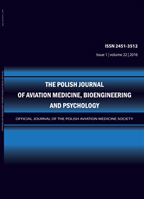2022, Volume 28, Issue 2
TIME COURSE OF BRAIN LACTATE AND GLUTAMINE CONCENTRATIONS FOLLOWING HIGH-INTENSITY PHYSICAL TRAINING: VALIDATING PROTOCOL OF A MAGNETIC RESONANCE SPECTROSCOPY STUDY
STEFAN P. GAŹDZIŃSKI1, ANNA PRZEWODZKA1, MICHAŁ MADEYSKI2, ALEKSANDRA PRZYBYSZ3, EWELINA MACULEWICZ4
-------------------------------------------------------------------------------------------------
1Creative Neuroscience Lab – CNS Lab, Military Institute of Aviation Medicine
2Military Institute of Medicine – National Research Institute
3Department of Biomedical Sciences, Józef Piłsudski University of Physical Education
4Department of Molecular Biology, Military Institute of Aviation Medicine
Autor korenspondencyjny: STEFAN P. GAŹDZIŃSKI; Creative Neuroscience Lab – CNS Lab, Military Institute of Aviation Medicine; email: sgazdzinski@wiml.waw.pl
Full text
Streszczenie
Introduction: This technical note presents work performed to validate the magnetic resonance spectroscopy (MRS) protocol used in our previous study. Earlier studies using MRS have reported changes in the concentrations of glutamate (Glu) and lactate (Lac) following exercise of various intensities and performed by participants at different fitness levels. However, the time-course of these changes within a few hours after a single strenuous exercise bout is not known. This information was essential to decide if the procedures to measure Lac and Glu could be added before and after a standard radiological exam lasting about 90 minutes, which is performed on candidates to the Polish Air Force University in Dęblin, who undergo medical evaluation at Military Institute of Aviation Medicine and are at very high fitness level. This evaluation also includes a maximal exercise test. Here, we asked whether such exercise-induced changes of brain Lac and Glu return to resting values within 60 minutes post-exercise.
Methods: Concentration changes of Glu, glutamate+glutamine (Glx), and Lac were measured in one person with outstanding performance. The MRS measurements were performed twice before the exercise and then within an hour, at 8-minute intervals, using MRS at 3T, within a large voxel encompassing bilateral occipito-parietal lobes.
Results: Glu, Glx, and Lac concentrations were elevated after the exercise, compared to pre-exercise concentrations. The Lac concentrations appeared to normalize (to pre-exercise values) within 60 minutes. However, Glu and Glx values seem to have larger concentrations after 60 minutes, compared to pre-exercise values. The general trend was the same for absolute concentrations and values scaled to total creatine signal (tCr), despite short-term deep in tCr concentration following the exercise.
Discussion: The results demonstrated the feasibility of using concentrations of Lac, Glu, and Glx obtained at about 60 minutes post-exercise to substitute for concentrations of these metabolites at rest.
Słowa kluczowe
glutamate, lactate, magnetic resonance spectroscopy, exercise, brain, time-course
